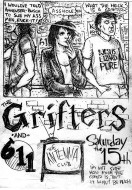When it comes to the history of alternative music and culture in
Memphis, all roads lead to the fabled Antenna Club, a grimy black hole
of a bar once situated on the northwest corner of Madison and Avalon,
between a pawn shop and a dentist’s office that was also — most
conveniently — a leasing office for inexpensive Midtown rental
properties. The Antenna, widely regarded as one of the first and
longest-lived punk-oriented venues in America, closed 14 years ago. It
was a hub for creativity in Memphis and is being remembered and
celebrated with a 26-band concert August 14th and 15th at Murphy’s and
at Nocturnal, the site of the original venue.

When the Crime played the Antenna Club in the early 1980s, lines
would snake down Madison and spill around the corner onto Avalon. The
band, which featured guitars and vocals by Jeff Golightly and Rick
Camp, was a risky experiment in a city where all the good-paying gigs
went to top-40 cover bands. But Golightly and Camp, who still play
together in a multigenerational band called the Everyday Parade, were
on a quest to play new wave and punk music in Memphis and to eventually
write their own songs. Before long, they were touring and playing
bigger clubs and coliseums around the region. But no matter how big the
gigs got, they always looked forward to coming home to the Antenna and
to Memphis’ burgeoning punk-rock scene.
 G. Brent Shrewsbury
G. Brent Shrewsbury
“We were part of somthing new,” says Golightly, who has a
conflicting gig and can’t participate in this weekend’s reunion. “The
folks we called ‘criminals’ were ready for us, and they were ready for
the scene that developed around the Antenna. The room is magical. We
packed the place on a regular basis, and the heat and sweat practically
made the place rain inside. When you put bodies in that space, the
sound was like nowhere else, and the Crime could make it pulsate.”
Panther Burns’ loquacious drummer Ross Johnson, who has attempted
but never finished a book on the Antenna Club, confesses, only somewhat
begrudgingly, that Golightly’s description of the early scene is
accurate. As a part of the snottier, noisier art-rock side of Memphis
punk, there was a time when Johnson couldn’t readily admit it was the
Crime’s smart power pop that kept the club’s doors open. “We could be
really cruel sometimes,” he says, remembering that he used to get a
kick out of sitting at the bar and heckling other bands. “Time softens
things,” he says, recalling the time he was thrown out of the club for
throwing a beer at his sometime-bandmate Alex Chilton.
Memphis’ punk scene got started in 1979, when the bar at 1588
Madison was still called the Well and local groups like Tav Falco’s
Panther Burns, the Randy Band, and the Klitz swapped out shows on the
weekends. In 1981, the property was sold to James Barker and Phillip
Stratton, who changed the name to the Antenna Club, painted the
interior black, mounted TV monitors on the walls, and started showing
RockAmerica music videos. They also started booking national acts.
Johnson says the videos, which were a novelty in 1981, a year before
MTV was available in Memphis, got old fast and that the outside booking
initially was met with resentment by locals, who liked having a
monopoly on the club’s stage.
When Steve McGehee, a former head waiter for TGIFridays, took the
club over from Barker and Stratton, outside booking became even more
aggressive.
“The club really started jumping, and more and more bands formed,”
Golightly says, recalling a period in the early 1980s when the Randy
Band’s bright pop and the heady new wave of Calculated X and Barking
Dog were showcased alongside the honky tonk swagger of Neon Wheels, the
privative stylings of the Klitz, and the noisy roots fusion of Panther
Burns and Milford & the Modifiers. “It was a scene where the famous
and the unknowns could share a stage,” Golightly says. “It was a venue
that would give any band a shot, as long as they brought a crowd that
drank some beer.”
The Antenna Club became as famous for the shows nobody saw as for
the ones everybody turned out to see. The first time R.E.M. played, the
club was barely able to scrap together enough cash to pay the band’s
$50 guarantee. McGehee remembers feeling completely alone while he
watched Mission of Burma play one of the greatest sets he’s ever
seen.
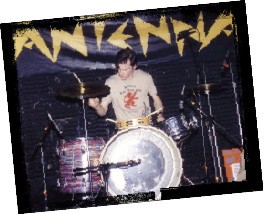 G. Brent Shrewsbury
G. Brent Shrewsbury
Alex Greene, a multi instrumentalist who’s played with Big Ass Truck
and Reigning Sound, was one of a handful of people who saw Detroit
garage legends the Gories when they played their first show in Memphis.
(A recent double reunion featuring the Gories and the Oblivians packed
the Hi-Tone to the point of discomfort.) And not every great show went
under-appreciated. “I believe we had the devil himself in here the
first night Black Flag played,” McGehee says.
In the ’80s, the Antenna became a regular stop for hardcore and punk
bands recording for Black Flag guitarist Greg Ginn’s SST label, bands
such as Hüsker Dü, the Meat Puppets, the Minutemen, and Bad
Brains.
Johnson says the club probably owes its longevity to the enduring
nature of Memphis’ hardcore scene. He attributes much of the lingering
interest in the venue to its successful embrace of all-ages shows. Cult
filmmaker Mike McCarthy, whose band Distemper played the Antenna’s
first all-ages show, has a simpler explanation. “The great irony is
this,” he says, “if you were an alternative person in Memphis in the
1980s, you only had one place to go.”
In July, McCarthy, who once shot a horror movie at the Antenna Club,
spent three weeks touring his latest film, Cigarette Girl,
around Australia, where it premiered as part of the Revelation Perth
International Film Festival. In 1983, however, McCarthy had another
kind of road trip in mind. After visiting Memphis and taking in a show
by an edgy New Mexico power pop band called the Philisteens, the Tupelo
native decided to move to the Bluff City to attend art school and play
rock-and-roll at the Antenna.

“I sat terrified in the parking lot of River City Donuts, scoping
the place out, watching the toughest dude I’d ever seen in my life
walking into the club wearing a black leather jacket and a mohawk,”
McCarthy says. “Amid the disorienting TV screens with the Sex Pistols
doing ‘God Save the Queen,’ and lights that turned my teeth as green as
Johnny Rotten’s, I realized that the punk I’d seen outside was merely
the waiter, Steve McGehee. That night defined punk for me.”
Although the Antenna had a reputation for being a punk club, all
kinds of bands played there. Before he moved to Athens, Georgia, and
wrote “The Night G.G. Allin Came to Town,” Patterson Hood lived in
Memphis and played the Antenna with his band, Adam’s House Cat. Nancy
Apple, a driving force behind Memphis’ singer/songwriter scene,
describes the Antenna as a “country-friendly” establishment, where she
gigged with Linda Gale Lewis and Cordell Jackson, the rockabilly
granny. “I always felt like I had hit the big time when I played
there,” Apple says, allowing that her brand of twang was often referred
to as “cowpunk.” “It was one of those places where there was almost
always a great crowd, no matter who was playing.”
Even rappers played the Antenna. “Big Ass Truck would serve as a
backup band to various rappers [playing the Antenna],” says Alex
Greene, citing a gig the band performed with the young Al Kapone.
The 1990s saw new scenes spring up around the Grifters, a brooding
quartet that mixed angular, atmospheric indie rock with blues and metal
flourishes, and around garage-rock innovators the Oblivians and Impala,
surf-rockers with a flare for squalling crime jazz and dirty rhythm and
blues.
 G. Brent Shrewsbury
G. Brent Shrewsbury
Shangri-La records founder Sherman Willmott, who produced many of
the Grifters’ first recordings, describes the Antenna as a place where
great shows received little or no promotion: “You always knew you were
going to be one of a handful of lucky people to see the best bands in
the world — like the Screaming Trees, the Chills, and Government
Issue — but you were never really sure if the band mentioned on
the club’s answering machine would play, when they arrived and saw a
broken sign, no posters for the show, a couple of underage girls, a
crazy looking doorman straight out of film-noir, punk-rock,
motorcycle-gang hell, and a couple Midtown hipsters hanging at the bar
watching RockAmerica videos and drinking stale keg beer.” Willmott
complains without actually complaining. “Only in Memphis could a club
run so poorly — no phone-answering, ever — survive for that
many years despite itself. God bless the Antenna Club, with all of its
open sores and decrepit beauty. It was like an alternative-universe
island in a nightmare town of classic rock.”
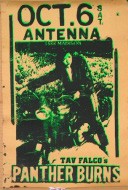
Like the King of Rock and Roll, who passed away after slipping from
his private Whitehaven throne in the wee hours of the morning, the
Antenna Club’s death was less than proud. A venue that hosted great
performances by the likes of Robyn Hitchcock, the Replacements, and
Suicidal Tendencies quietly closed following a poorly attended concert
by a disposable buzz band called Tripping Daisy.
According to the club’s last manager, Mark McGehee, who’d taken over
operations from his brother, Steve, things “went kind of sour” when he
told the band that he couldn’t possibly meet the pre-arranged $680
guarantee. Commercial Appeal reporter Larry Nager noted in an
article about the club’s closing that after combining monies from the
door, beer sales, and the cigarette machine, McGehee only had $400 and
that wasn’t enough to satisfy the band. That’s when McGehee decided he
was finished. When the media inquired, he told them the club had closed
because live entertainment was dying in Midtown. He added that
alternative music had become mainstream, and the Antenna Club had
outlived its usefulness.
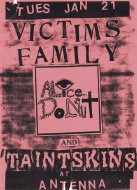
But like a stubborn ghost, the Antenna Club never left the building.
The property’s next two incarnations, the Void and Barristers, were
short-lived alt-rock clubs in the mold of their famous predecessor. In
1997, the space was significantly renovated, decorated with
red-and-white candy-striped furniture, and rebranded as a tony lesbian
bar called the Madison Flame. The club’s owners would occasionally book
rock shows for Midtown bands and music fans, who regarded 1588 Madison
Avenue as holy ground. Nocturnal, the club currently located on the
site, features a regular slate of live music.
But this weekend, the ghost returns from punk purgatory, and the
Antenna Club will live once more — at least for a couple of
days.
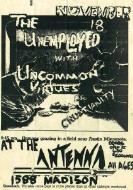
The A List
Hundreds of bands played the Antenna Club. These are a few of
them:
The Replacements, The Fall, Neon Wheels, Dead Milkmen, Suicidal
Tendencies, Mudboy & the Neutrons, R.E.M., Angerhead, Odd Jobs,
Pezz, The Bongos, The Randy Band, Adam’s House Cat, Widespread Panic,
Teen Idols, The Compulsive Gamblers, NRBQ, Greg Hisky, Guided by
Voices, Calculated X, The Gun Club, Trusty, Impala, Linda Heck &
the Trainwreck,The Hellcats, The Gories, The Verbs, The Country
Rockers, The Marilyns, Jason & the Scorchers, Mojo Nixon, Vibration
Society, The Oblivians, Gene Loves Jezebel, Black Flag, The Scam, Think
as Incas, Los Pimpin, Love Tractor, Flaming Lips, Metro Waste, Big Ass
Truck, G.G. Allin, The Modifiers, Paul Burleson, Man With Gun Lives
Here, Panther Burns, The Cadillac Cowgirl, Neighborhood Texture Jam,
Beanland, Crowded House, Circle Jerks, Alice Donut, The Bum Notes, The
Klitz, DDT, Hüsker Dü, The Generics, Sobering Consequences,
The Grifters, Econochrist, Meat Puppets, The Simpletones, Alex Chilton,
Hole, Bad Brains, Taintskins, Mission of Burma, White Animals, Royal
Crescent Mob, Barking Dog, Xavion, Bob’s Lead Hyena, The Crime, Robyn
Hitchcock, Busta Jones, The Minutemen, Webb Wilder, The Plimsouls,
Uncle Tupelo, Cordell Jackson, Green Day.
